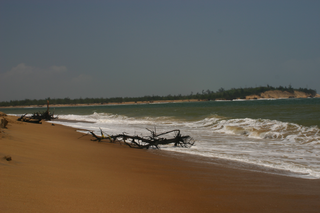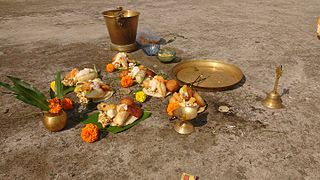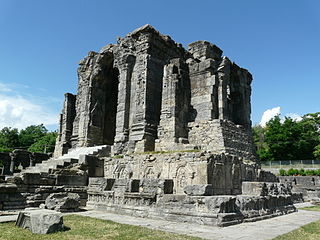Karnak and similar may mean:
Konark Beach is situated in Odisha on the eastern coast of India and is considered to be India's finest beach. The Ramchandi Temple is situated about 10 km along the beach.It is very famous tourist place.
There are several Hindu temples in Multan, a city in the Punjab province of Pakistan. The temples, known as Mandirs, exist because a portion of the population of Multan followed Hinduism, Buddhism and tribal religions before the arrival of Islam. In 997 CE, Sultan Mahmud Ghaznavi, took over the Ghaznavid dynasty empire established by his father, Sultan Sebuktegin, In 1005 he conquered the Shahis in Kabul in 1005, and followed it by the conquests of Punjab region. The Delhi Sultanate and later Mughal Empire ruled the region. There were two places in Multan from that period of considerable antiquity.
Ramachandi Temple, is on a beautiful spot on the banks of the Kusabhadra River where it flows into the Bay of Bengal. It is only 5 km away from Konark in the Puri District of Odisha. Goddess Ramachandi, the deity of Konark is thought by some to be the presiding deity of this temple, while others thought it to be the temple of Mayadevi, wife of Surya.

The Eastern Ganga dynasty was a medieval Indian dynasty that reigned from Kalinga from the 11th century to the early 15th century. The territory ruled by the dynasty consisted of the whole of the modern-day Indian state of Odisha as well as parts of West Bengal, Andhra Pradesh and Chhattisgarh. The early rulers of the dynasty ruled from Dantapura; the capital was later moved to Kalinganagara, and ultimately to Kataka. Today, they are most remembered as the builders of the Konark Sun Temple, a UNESCO World Heritage site at Konark, Odisha.
Multan in Punjab province of Pakistan is one of the oldest cities in South Asia, though its exact age has yet to be determined. It has seen a lot of warfare because of its location on a major invasion route between South and Central Asia. It is famous for its Sufi shrines.

Ratha Saptami or Rathasapthami is a Hindu festival that falls on the seventh day (Saptami) in the bright half of the Hindu month Maagha. It is symbolically represented in the form of the Sun God Surya turning his Ratha (Chariot) drawn by seven horses towards the northern hemisphere, in a north-easterly direction. It also marks the birth of Surya and hence celebrated as Surya Jayanti.

Surya is a Sanskrit word that means the Sun. Synonyms of Surya in ancient Indian literature include Āditya, Arka, Bhānu, Savitru, Pushana, Ravi, Mārtanda, Mitra and Vivasvāna.

Tourism in Odisha is one of the main contributors to the Economy of Odisha, India, with a 500 km (310 mi) long coastline, towering mountains, serene lakes and frolicking rivers. Odisha is one of the major tourism sectors of India, with various tourists' attractions, ranging from wildlife reserves, beaches, temples, monuments, the arts and festivals. Other than wildlife reserves, beaches, temples, monuments, the arts and festivals, the Odisha Tourism Development Corporation, a Public Sector Undertaking of Government of Odisha, is also developing tourism sector of Odisha and India.

The Biranchi Narayan Sun Temple, also known as the Abode of Viranchinarayana or the Wooden Konark, is a Hindu Temple located in the town of Buguda in Ganjam, Odisha. It is the second Surya temple constructed in Odisha, after the famous Konark Sun Temple.

Samba Dashami is a festival unique to the state of Odisha, India. It is celebrated on the 10th day of the Sukla Paksha of Pausha Masa or waxing phase of moon in Paush month as per traditional Odia calendar. This festival is especially celebrated in the eastern part of Odisha.
Samba was a son of Krishna, the Hindu god, and Jambavati. His half-brother was Pradyumna. His actions, caused by anger, brought an end to the Yadu dynasty.

Prahladpuri Temple was an ancient Hindu temple located in Multan city of Punjab province in Pakistan, adjacent to the Shrine of Bahauddin Zakariya. It was named after Prahlada and dedicated to the God Narasimha. The temple is presently in ruins, since its destruction in 1992 by a Muslim mob in retaliation for the destruction of the Babri Mosque in Ayodhya, India by a Hindu mob earlier that year.
Kalapahad or Kala Pahar was a Muslim General of Gour Sultanate, who is mentioned in the Mughal Empire records as the one who attacked Jagannath Puri with his army to tear down the Konark temple. However, the general Kalapahad and his army may not have been entirely responsible. Other texts state that the temple was sacked several times by Muslim armies between the 15th and 17th centuries. Islamic texts describing the raids of Kalapahar mention his army's first attempt to destroy the temple in 1565, but they failed. They inflicted only minor damage and carried away the copper kalasa.
A sun temple is a building used for religious or spiritual activities, such as prayer and sacrifice, dedicated to the sun or a solar deity. Such temples were built by a number different cultures and are distributed across the world including in India, China, Egypt, Japan and Peru. Some of the temples are in ruins, undergoing excavation, preservation or restoration and a few are listed as World Heritage Sites individually or as part of a larger site, such as Konark.

Arasavalli Sun Temple is a 7th-century AD Sun Temple at Arasavalli in Andhra Pradesh, India. It is situated in Arasavalli Village at a distance of 1 km east of Srikakulam Town. It is believed that the temple was built by king Devendra Varma, ruler of the Kalinga Dynasty. The temple is still being visited today and is one of the most popular tourist attractions in the town.This temple is considered as one of the oldest sun temples in India












